A NOTE FROM STACEY: While Bonnie Kaplan needs no introduction amongst the members of this writing community, I feel compelled to write something to start off her guest blog post. As many of you know, Bonnie is a passionate educator from New York State. Anyone who has ever read Bonnie’s blog, followed her on Twitter, or who has been lucky enough to break bread with her knows she has strong beliefs about education. On any given day I find Bonnie and I read and share many of the same NY Times articles on Facebook and Twitter. Like you, we both believe in public education and want to make “the system” the best it can be.
Bonnie recently traveled to Finland to learn about their education system first-hand. I followed her trip via Facebook and couldn’t wait to hear her thoughts upon her return. Therefore, I e-mailed her while she was away and invited her to share some reflections from with our community. So, without further ado, I give you Bonnie Kaplan.
I spent most of my twenty-eight years of high school English teaching in two New York State school districts and in two classrooms. Both rooms were tucked away from the rest of the rooms on their floors. As the high school drama teacher, I had some dramatic license from colleagues and administrators, and it wasn’t unexpected to hear a bit of shouting and rumbling coming out of 101 and 310. My classrooms were my islands where I was left free to create an environment that allowed my students to feel safe, to be themselves and learn along with me. I think most teachers felt that same freedom and respect. Their classrooms were their castles.
Sadly, in recent years, that freedom has been dramatically stripped away from many public school teachers in the United States, which brings me to Finland. As a committed blogger who shares my Slices of Life regularly at Two Writing Teachers, I have been reading, writing and sharing posts about Finland’s work in school reform on my blog, Facebook and Twitter -so it didn’t come as a surprise to friends in my online communities when I finally figured out the best way to see what Finnish schools were really like for myself.
The perfect storm fell into my lap when my Hudson Valley Writing Project teacher buddy, Christine McCartney, won a Fulbright to study the Finnish schools during this spring semester. It was always a given that I would join her, just a matter of when it would be warmest. As we got closer to my arrival date in late April, Christine scheduled an intense week and a half of interviews for us with education professors at the teacher training university in Tampere and with classroom teachers, teacher trainees, and administrators in the local schools and in one teacher training school in Helsinki, the country’s capital.
With the doors wide open, I was able to walk freely through the schools with my cameras, documenting the daily school experiences in hallways, classrooms, cafeterias, and playgrounds. While many students were a bit shy of the camera, teachers were more than willing to open their classrooms to us and meet during their free periods and after school for interviews.
In a Youtube video I watched about Finland a few years ago, I remember the sign RELAX hung over the school entrance and yes, walking in and out of schools I felt relaxed in their open spaces. With a luxurious break of 15 minutes between classes in the middle and high schools, students met together, checked email and read quietly. Teachers in faculty rooms congregated with cups of coffee and conversed comfortably. No one raced from class to class and by late morning, the aroma of home cooked food wafted throughout the building and everyone enjoyed a free lunch on real plates in the cafeterias. One teacher trainee recalled the cook at her school by saying “she cooked for us everyday, and did so happily… she loved us all.”
We were both impressed with many of the school norms we observed and learned about from the variety of teachers we spoke with. It was exciting to learn that elementary teachers are the most respected in the school community and spots in their early education training programs are the most difficult to land. Positions, especially in the earliest years of the school experience are the most sought after. To establish a strong community of learners, teachers move with their students from grades 1-3 and then 4-6 and even in the middle school, when it is possible, one teacher stays with her students in English as a Foreign Language, for example. This allows for wonderful continuity in the school community for the teacher, her students, and their parents.
Children on the other hand, as they come to the end of Middle School in ninth grade, have a choice before them. Do they apply to traditional high school or look into a vocational education program with a wide variety of choices? At one time, most students opted for the academically-geared schools, but now it’s about 50/50. Either path is open to them and the education is of a high quality in both vocational and traditional programs. The paths continue to be open, even if they change their minds and no one is burdened with college loans: education is free preK-university in this socialist country.
So by now, if you’re thinking, yes, that all sounds good, but how do we compare a country with a fairly homogeneous population of five and a half million people, with less than 5% of the population in poverty, to the United States? Well, forty years ago, when Finland was overhauling their education system and studying models from other countries, they could have followed our lead and jumped on our No Child Left Behind bandwagon, eventually moving to high-stakes testing and teacher assessment as a means to improve education. Check out Christine’s wonderful video comparing the educational reform trajectories of United States with Finland’s.
Instead, they moved in a very different direction. The center of their community is the child and the education system they continue to improve offers a great public school education for all children, demanding that teachers compete for a spot in a rigorous teacher training program including a in-depth foundation in teacher reflection and collaboration- a habit that continues beyond the university experience. After all, the teacher is not to blame if students are falling short, but the whole community that needs to take responsibility. Finnish school communities are charged to provide their children with safe environments to allow them to play, create and collaborate.
Sitting across from Antti Hitti, a young teacher trainer at Tampereen Normaalikoulu, and listening to him speak proudly about the autonomy he and he colleagues enjoy in their classrooms, I ached for the teachers I work with at the Hudson Valley Writing Project and in our service-area schools who are burdened with the high stakes tests, tied to their annual assessments.
Back home, as I start to sift through the hours of video interviews we collected for the documentary we will create and share when Christine returns in June, I wonder how I can best share what I’ve learned and what I can do to support the teachers I know well, who deserve that same respect and freedom the teachers in Finland enjoy. One event will be held on Saturday, June 8. I’ll be marching with fellow teachers, administrators, parents and students at the One Voice United Rally in Albany, New York, calling for an end to political obsession with high stakes testing and corporate control of public education.
Bonnie Kaplan spent 28 amazing years teaching English/Drama grades 7-12. Five years before she was even thinking about retiring, the Hudson Valley Writing Project fell into her lap and after her first summer as a teacher consultant in 1999, she became a Co-Director of the project. She has never stopped learning with the techies of the National Writing Project and the great teachers who write with Stacey and Ruth at Two Writing Teachers.
When she can get herself unglued from the computer, she grabs her guitar and plays a mean Mozart with the Pluck guitar orchestra.

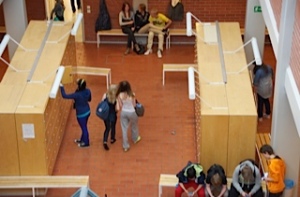

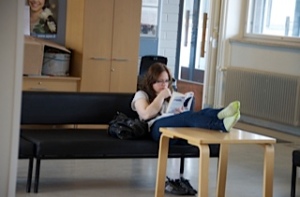
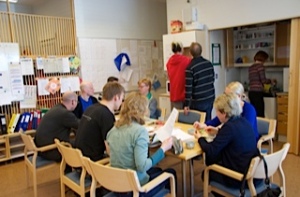
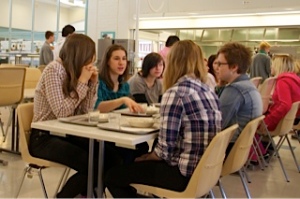
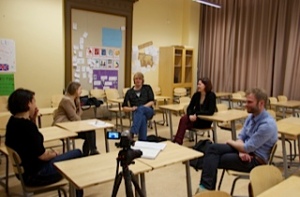

Thank you for this inspiration during this moment of intense end of year assessment!
LikeLike
Thinking about you Eric 🙂
LikeLike
Reblogged this on Eric Ryan Grant and commented:
Great article about a great education system!
LikeLike
Thanks Eric 🙂
LikeLike
…and now I want to move to Finland. Seriously though, I’ve been a parent to kids in public, parochial and private schools. Other than the public schools in the wealthier areas, private schools have hands down created a more civil & respectful atmosphere for my children. “Real food on real plates” is a very telling indicator of the VALUE we place on our kids: an indication of their worth. I mentor and serve in an urban public school and the problems are systemic, yet always seem to link to poverty. I think a study into Finnish culture & economics & human services would be most relevant to this discussion.
LikeLike
Stacie,
Being in Finland makes me feel worse in some respects. We are not taking care of our poor and spending money torturing everyone else. I don’t know why we aren’t more humane in America. I’m in a state of despair if I’m being honest.
LikeLike
Thank you so much for this insightful post! I must admit that I feel kind of sad now. Your words – “the center of the community is the child,” and “After all, the teacher is not to blame if students are falling short, but the whole community that needs to take responsibility. Finnish school communities are charged to provide their children with safe environments to allow them to play, create and collaborate.” This is beautiful. How might such words be said about the American education system? It seems to me that we need a paradigm shift, culturally. How does such a shift occur?
LikeLike
I don’t know Maureen. It seems simple when you are in the place it’s happening, but back home, we are chasing our tails.
LikeLike
I just commented on your blog, Bonnie, didn’t realize your post was here too. I am happy to hear about your journey, yet my continuing question is how do we start down that path? And how did we let others make such decisions for us? I am sorry for the pressure on teachers especially and then of course, the pressure on the children. It isn’t a good path to continue down.
LikeLike
And when does it stop, when do we turn around?
LikeLike
Thanks so much for your in-depth reading and analysis of our work 🙂
LikeLike
This was an amazing article that needs to be shared at the national level. I loved the historic way our two systems were compared. The opening setting including the sign ‘relax’ made me want to be there to experience this community. I also love the idea of looping up with the students continually through the system. Thank you so much for sharing your experience, Bonnie and your service to the students and teachers in our country. We over assess and teaching and learning is at stake. I feel that there should be protests in every city, in every hamlet!
LikeLike
Thanks for your compliments. I am very lucky for the opportunities I’ve had and very frustrated that too many teachers are not respected and trusted and free to teach with passion.
LikeLike
Reblogged this on college access live and commented:
An interesting perspective on education in Finland vs. the United States. The biggest point I took away from the video and article is the different mindset the two countries posses in their approach to education. In the case of Finland, it seems that consistency has yielded positive results. However, the United States has an educational system clogged by reform and political change. Perhaps it is time we take a step back from education as a political facet, and view it as a crucial institution to the country’s success. The basic idea of educating someone does not change. The tools and techniques used to provide education are mailable. Allow teachers flexibility so that they may teach best to their students needs. The United States is not a homogenous people. We all have different learning styles and needs in the classroom. Students are more than statistics and scores.
LikeLike
Agreed. Now when will the necessary shift take place 🙂
LikeLike